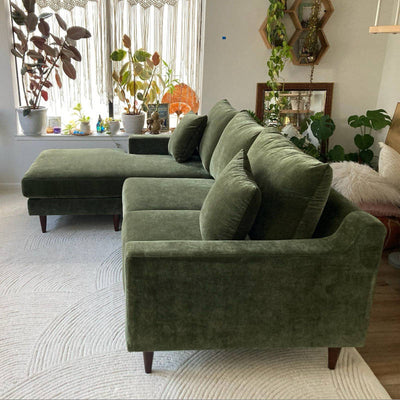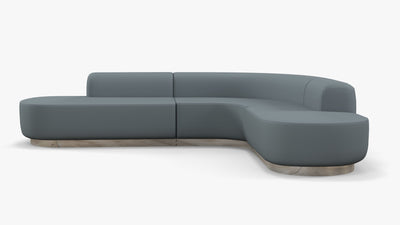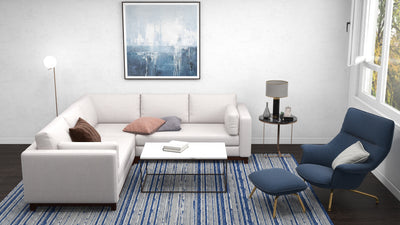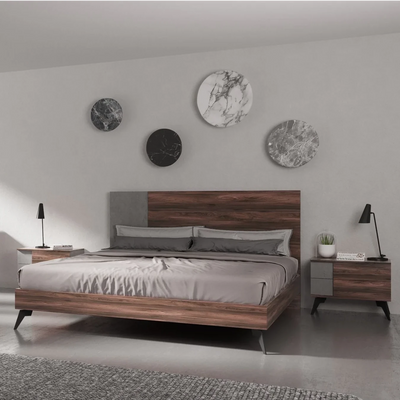General Routine Care
Proper maintenance is key to keeping your furniture looking fresh. Here are the best practices for regular care.
Vacuuming
- Vacuum at least once a week to remove dust, dirt, pet hair, and crumbs. This prevents debris from embedding into the fibers and causing damage over time.
- Use a soft brush attachment or an upholstery-specific nozzle to gently clean the fabric without damaging it.
Fluff Cushions and Pillows
- Regularly fluff pillows and cushions to help maintain their shape and prevent uneven wear. Rotate or flip cushions to avoid sagging or compressing in one spot.
Avoid Sunlight
- Keep furniture away from direct sunlight to avoid fading, especially for darker fabrics. UV rays can weaken fibers over time, leading to color loss.
Spot Cleaning Stains
Accidents happen, and knowing how to spot clean will help keep your furniture looking pristine between deep cleans. Follow these steps for effective spot cleaning.
Step 1: Identify the Stain
-
Determine the type of stain (oil-based, water-based, food, ink, etc.) before attempting to clean it, as different stains require different cleaning methods.
Step 2: Blot, Don’t Rub
-
Use a clean, dry cloth or paper towel to blot (not rub) the stain. This absorbs as much of the liquid as possible and prevents it from setting deeper into the fabric fibers.
Step 3: Apply Cleaning Solution
- Water-Based Stains: For water-based stains (like coffee, wine, or juice), mix a small amount of mild dish soap with water and dampen a cloth with the solution. Gently blot the stained area. Rinse with clean water afterward, and blot dry with a dry cloth.
- Oil-Based Stains: For oil-based stains (such as grease or lipstick), sprinkle some cornstarch or baking soda on the stain and let it sit for 15-30 minutes. Brush off the powder and apply a small amount of rubbing alcohol using a clean cloth.
- Tough Stains: For stubborn stains, you may need a speciality cleaner for your fabric type (check care labels). Always test on a small hidden area first to ensure it won't damage the fabric.
- We recommend Folex Instant Carpet Spot Remover or Crypton Purple or Gold Upholstery Stain Remover, which are safe to use on all of our fabrics.
Understanding Cleaning Codes
Most fabrics will have a cleaning code to guide you on how to clean them. These codes refer to the type of cleaning solution or solvent that should be used.
W: Water-Based Cleaning
-
The fabric can be cleaned with water-based solutions, like mild soap and water.
-
Use a damp cloth with a gentle detergent solution for light cleaning. Avoid saturating the fabric, and always dry the area thoroughly.
S: Solvent-Based Cleaning
-
The fabric should be cleaned using solvent-based products (dry cleaning). Water may cause damage or discoloration.
-
Use a dry cleaning solvent or take the piece to a professional dry cleaner. Do not attempt to clean with water.
WS: Water and Solvent-Based Cleaning
-
The fabric can be cleaned with either water-based or solvent-based cleaning solutions, giving you flexibility depending on the stain and fabric.
-
Use a water-based cleaner for light stains or a solvent cleaner for more stubborn stains. Always follow the care label instructions.
Leather Furniture Care
Leather furniture is a sophisticated and durable option, but it requires specific care to maintain its appearance and longevity.
Routine Cleaning
- Dust Regularly: Dust leather furniture regularly with a soft cloth to keep dirt and dust from settling into the surface.
- Vacuum: Use a vacuum with a soft upholstery attachment to remove debris and prevent buildup on the leather.
- Minor scratches such as fingernail scratches or light scuffs may cause a slight mark without truly damaging the leather. Start by using a chamois or your fingers to gently buff minor scratches or scuffs on the surface. Sometimes this is enough to correct minor scuffs and scratches.
Cleaning Leather
- Mild Soap and Water: For regular cleaning, mix a small amount of mild soap (such as baby shampoo or a leather-specific cleaner) with water. Dampen a soft cloth with the solution, then gently wipe down the leather surface. Avoid soaking the leather.
- Dry Immediately: Wipe off excess moisture with a dry cloth and let the leather air dry at room temperature. Avoid direct heat sources.
Conditioning Leather
- Leather Conditioner: Every 6-12 months, apply a high-quality leather conditioner to nourish the leather and prevent it from drying out or cracking. Follow the manufacturer’s instructions, and always test the conditioner in a small, hidden area first.
- Buff Gently: After conditioning, use a soft cloth to buff the leather and restore its natural sheen.
Spot Cleaning Leather
- Oil and Grease Stains: Use a mild solution of water and mild soap, or gently rub the affected area with a leather cleaner designed for oil-based stains. For grease stains, apply cornstarch and let it sit for several hours, then gently brush it away.
- Ink Stains: For ink stains, lightly dab the area with rubbing alcohol using a cotton ball. Be sure to test this method on an inconspicuous area first.






















